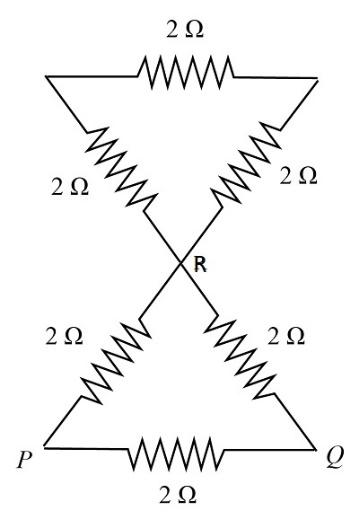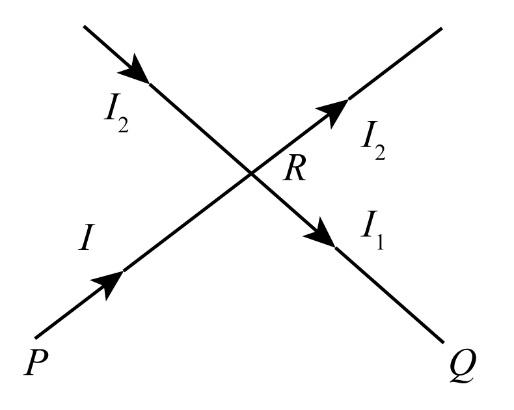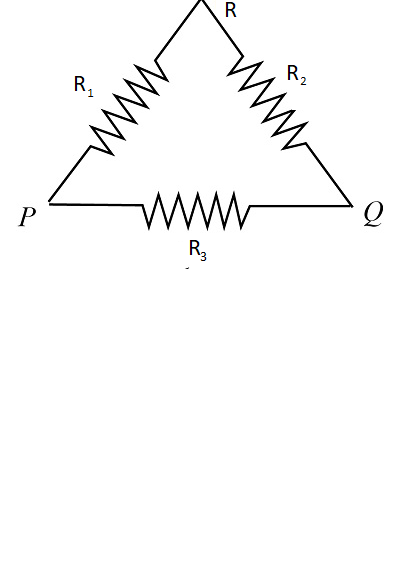
In the given figure, equivalent resistance between points P and Q is

(A) $\dfrac{1}{3}\;{\rm{\Omega }}$
(B) $\dfrac{4}{3}\;{\rm{\Omega }}$
(C)$\dfrac{2}{3}\;{\rm{\Omega }}$
(D) $2\;{\rm{\Omega }}$

Answer
563.1k+ views
Hint: In this type of questions, you need to apply the concept of equivalent resistance. Firstly, you need to figure out whether the upper part of the circuit will have an impact on the equivalent resistance or not. This can be done by applying KCL about the junction point. Later you can calculate the equivalent resistance by applying series and parallel combination.
Complete step by step answer:
Let us consider a point, say R at the junction. If we say that the current starts to flow from end P to other branches of the resistors. We can see the flow of the current in the figure given below,

The point R acts as the junction point. So, applying Kirchhoff’s Current Law (KCL) in the circuit, we get,
$I + {I_2} = {I_2} + {I_1}$
Further solving the above expression, we will get,
$I = {I_1}$
From this, we can say that the current will flow the same from point P to R, and then R to Q. The current will not flow through the upper part of the circuit. The remaining circuit we will obtain is,

Here, resistors ${R_1}$ and ${R_2}$ are in series combination to each other.

So the equivalent resistor of these both can be calculated as,
$R = {R_1} + {R_2}\\$
$\implies R = {\kern 1pt} 2\;{\rm{\Omega }} + 2\;{\rm{\Omega }}\\$
$\implies R = 4\;{\rm{\Omega }}$
This obtained equivalent resistance is in parallel combination with the resistor ${R_3}$. Therefore, the equivalent resistance of the circuit is given as,
$\dfrac{1}{{{R_{eq}}}} = \dfrac{1}{R} + \dfrac{1}{{{R_3}}}\\$
$\implies \dfrac{1}{{{R_{eq}}}} = \dfrac{1}{{2\;{\rm{\Omega }}}} + \dfrac{1}{{4\;{\rm{\Omega }}}}\\$
$\implies \dfrac{1}{{{R_{eq}}}} = \dfrac{1}{{2\;{\rm{\Omega }}}} + \dfrac{1}{{4\;{\rm{\Omega }}}}\\$
$\implies {R_{eq}} = \dfrac{4}{3}\;{\rm{\Omega }}$
Therefore, the equivalent between the point P and Q is $\dfrac{4}{3}\;{\rm{\Omega }}$.
Therefore, the option (B) is the correct answer.
Note:
You can make a mistake in the calculation while considering the upper part for the solution. Although you can use it, it would be lengthy and time-consuming. All the resistance, other than one between point P and Q will be in series. The equivalent resistance obtained will be in parallel combination with the resistor between point P and Q.
Complete step by step answer:
Let us consider a point, say R at the junction. If we say that the current starts to flow from end P to other branches of the resistors. We can see the flow of the current in the figure given below,

The point R acts as the junction point. So, applying Kirchhoff’s Current Law (KCL) in the circuit, we get,
$I + {I_2} = {I_2} + {I_1}$
Further solving the above expression, we will get,
$I = {I_1}$
From this, we can say that the current will flow the same from point P to R, and then R to Q. The current will not flow through the upper part of the circuit. The remaining circuit we will obtain is,

Here, resistors ${R_1}$ and ${R_2}$ are in series combination to each other.

So the equivalent resistor of these both can be calculated as,
$R = {R_1} + {R_2}\\$
$\implies R = {\kern 1pt} 2\;{\rm{\Omega }} + 2\;{\rm{\Omega }}\\$
$\implies R = 4\;{\rm{\Omega }}$
This obtained equivalent resistance is in parallel combination with the resistor ${R_3}$. Therefore, the equivalent resistance of the circuit is given as,
$\dfrac{1}{{{R_{eq}}}} = \dfrac{1}{R} + \dfrac{1}{{{R_3}}}\\$
$\implies \dfrac{1}{{{R_{eq}}}} = \dfrac{1}{{2\;{\rm{\Omega }}}} + \dfrac{1}{{4\;{\rm{\Omega }}}}\\$
$\implies \dfrac{1}{{{R_{eq}}}} = \dfrac{1}{{2\;{\rm{\Omega }}}} + \dfrac{1}{{4\;{\rm{\Omega }}}}\\$
$\implies {R_{eq}} = \dfrac{4}{3}\;{\rm{\Omega }}$
Therefore, the equivalent between the point P and Q is $\dfrac{4}{3}\;{\rm{\Omega }}$.
Therefore, the option (B) is the correct answer.
Note:
You can make a mistake in the calculation while considering the upper part for the solution. Although you can use it, it would be lengthy and time-consuming. All the resistance, other than one between point P and Q will be in series. The equivalent resistance obtained will be in parallel combination with the resistor between point P and Q.
Recently Updated Pages
A man running at a speed 5 ms is viewed in the side class 12 physics CBSE

The number of solutions in x in 02pi for which sqrt class 12 maths CBSE

State and explain Hardy Weinbergs Principle class 12 biology CBSE

Write any two methods of preparation of phenol Give class 12 chemistry CBSE

Which of the following statements is wrong a Amnion class 12 biology CBSE

Differentiate between action potential and resting class 12 biology CBSE

Trending doubts
What are the major means of transport Explain each class 12 social science CBSE

Which are the Top 10 Largest Countries of the World?

Draw a labelled sketch of the human eye class 12 physics CBSE

Explain sex determination in humans with line diag class 12 biology CBSE

Explain sex determination in humans with the help of class 12 biology CBSE

Differentiate between homogeneous and heterogeneous class 12 chemistry CBSE




